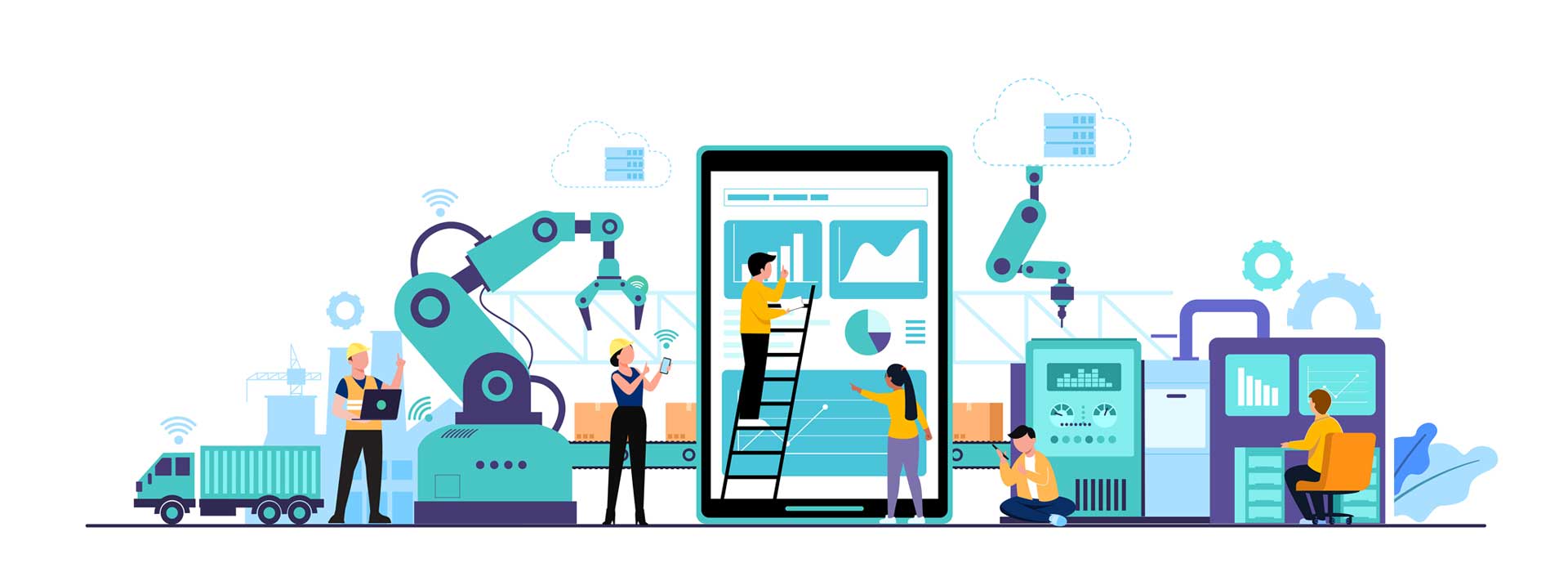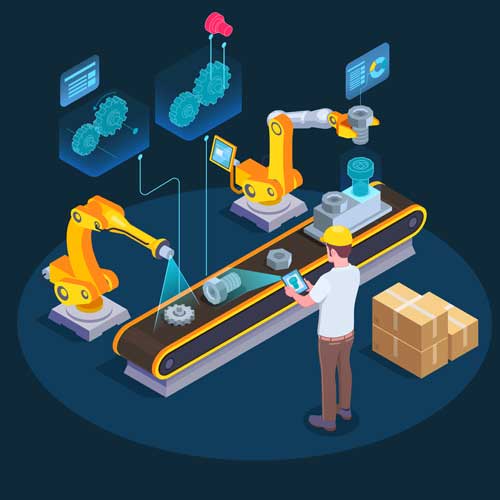
Introduction to Industrial Automation
Industrial automation has revolutionized the way we produce goods and manufacture products. From automotive assembly lines to food processing plants, automation has become an integral part of modern manufacturing and production processes.
But what exactly is industrial automation, and how does it work?
In this blog post, we’ll provide an overview of industrial automation, its benefits, and its challenges. We’ll also explore some of the emerging technologies that are shaping the future of industrial automation.
Whether you’re a student, engineer, or business owner, this post will provide you with a solid understanding of what industrial automation is, and why it’s so important in today’s world.
So let’s dive in!
What is Industrial Automation?
Industrial automation refers to the use of advanced technology and control systems to automate and optimize industrial processes, manufacturing, and production. It involves the use of various types of Industrial Automation Products including sensors, controllers, actuators, and communication networks.
Industrial automation systems are designed to improve efficiency, productivity, safety, and quality while reducing costs and minimizing waste.
There are many industries and processes where industrial automation is used, such as:
Automotive Manufacturing: Industrial robots are used to perform tasks such as welding, painting, and assembly.
Food Processing: Automation is used to sort, wash, package, and label food products.
Chemical Processing: Automation is used to control the flow of chemicals and monitor chemical reactions.
Oil and Gas: Automation is used to control drilling operations, pipeline transport, and refinery processes.
Pharmaceuticals: Automation is used to control the mixing, filling, and packaging of drugs.
It’s important to note that industrial automation is different from home automation. Home automation refers to the use of technology to control household appliances, lighting, climate, and security systems. While there are some similarities between industrial and home automation, industrial automation typically involves more complex systems, specialized equipment, and higher levels of precision and reliability.
How Does Industrial Automation Work?
Industrial automation systems consist of several components that work together to automate industrial processes. These components include sensors, controllers, actuators, and communication networks.
Here’s a brief overview of each component and how they work together:
Sensors: Sensors are used to detect physical or environmental changes in a process or system. These changes can be temperature, pressure, humidity, motion, or the presence of a certain material. Sensors convert the detected signal into a measurable electrical signal that is sent to the controller.
Controllers: Controllers are the “brains” of an industrial automation system. They receive signals from sensors and make decisions based on pre-programmed instructions or algorithms. Controllers can adjust the speed of a motor, open or close a valve, or turn on or off a conveyor belt, among other actions.
Actuators: Actuators are devices that convert electrical signals from the controller into physical actions. For example, a pneumatic actuator can open or close a valve, while a motor can turn a conveyor belt.
Communication Networks: Communication networks are used to connect sensors, controllers, and other devices in an industrial automation system. These networks can be wired or wireless and use different communication protocols.
In an industrial automation system, sensors detect changes in the process, and send signals to the controller. The controller then analyzes the signals and decides what actions to take based on pre-programmed instructions. The controller sends electrical signals to the actuators, which carry out the desired physical actions. The communication network allows all the components to work together seamlessly.
Overall, industrial automation systems work by using sensors, controllers, actuators, and communication networks to monitor and control industrial processes, leading to increased efficiency, productivity, safety, and quality.

Benefits of Industrial Automation
Industrial automation has numerous benefits for businesses and industries, including increased productivity, efficiency, and safety.
Here are some of the key benefits of industrial automation:
Increased Productivity: Industrial automation can improve productivity by reducing the time required to complete tasks, minimizing downtime, and increasing throughput. Automation can also help businesses increase their production output without having to increase their workforce.
Improved Efficiency: Automation can optimize industrial processes by eliminating repetitive tasks, reducing errors, and improving quality control. Automation can also help businesses reduce their energy consumption, material waste, and operating costs.
Enhanced Safety: Automation can improve workplace safety by reducing the risk of accidents and injuries. Automation can also reduce the exposure of workers to hazardous materials or environments.
Improved Product Quality: Automation can improve the consistency and quality of products by reducing variability and errors. Automation can also help businesses meet quality standards and regulations.
Examples of how automation has improved industrial processes and products include:
Automotive Manufacturing: Automation has transformed the automotive industry, with robots performing tasks such as welding, painting, and assembly. Automation has improved productivity and quality, while reducing costs and waste.
Food Processing: Automation has improved the efficiency and quality of food processing, with machines sorting, washing, packaging, and labeling food products. Automation has also improved food safety by reducing the risk of contamination.
Pharmaceuticals: Automation has improved the efficiency and accuracy of pharmaceutical manufacturing, with machines mixing, filling, and packaging drugs. Automation has also improved drug safety by ensuring consistent dosages and reducing the risk of contamination.
Oil and Gas: Automation has improved the efficiency and safety of oil and gas operations, with machines controlling drilling, pipeline transport, and refinery processes. Automation has also reduced the risk of accidents and environmental damage.
Overall, industrial automation has numerous benefits that can help businesses improve productivity, efficiency, safety, and product quality, while reducing costs and waste.
Challenges of Industrial Automation:
While industrial automation has many benefits, there are also several challenges associated with implementing automation in industrial processes.
Here are some of the key challenges of industrial automation:
High Upfront Costs: The initial cost of implementing an industrial automation system can be high, as it involves purchasing equipment, software, and other components. This can be a significant investment for businesses, particularly small and medium-sized enterprises.
Technical Complexity: Industrial automation systems can be complex, requiring specialized knowledge and expertise to design, install, and maintain. Technical complexity can also make it difficult to integrate new automation systems with existing ones.
Need for Skilled Labor: Implementing and maintaining industrial automation systems requires skilled labor, including engineers, technicians, and operators. The shortage of skilled labor can make it challenging for businesses to adopt and maintain automation systems.
Security Risks: Industrial automation systems can be vulnerable to cyber-attacks and other security threats. Securing automation systems requires implementing robust security measures, such as firewalls, access controls, and encryption.
Resistance to Change: Implementing industrial automation can also face resistance from workers who fear job loss or changes in their roles. Addressing these concerns requires effective communication and training programs to help workers adapt to the new system.
Overall, these challenges can make it difficult for businesses to adopt and implement industrial automation systems. However, with proper planning, investment, and training, businesses can overcome these challenges and reap the benefits of industrial automation.
Future of Industrial Automation:
The future of industrial automation is shaped by emerging technologies like artificial intelligence (AI), machine learning, and the Industrial Internet of Things (IIoT). These technologies are expected to transform the way we design, build, and operate industrial systems.
Here are some of the trends and developments that are shaping the future of industrial automation:
Artificial Intelligence (AI): AI is poised to revolutionize industrial automation by enabling machines to learn and adapt to changing conditions. AI can help businesses optimize their production processes, reduce waste, and improve product quality. AI can also help predict maintenance needs and reduce downtime.
Machine Learning: Machine learning is a subset of AI that involves training machines to recognize patterns and make decisions based on data. Machine learning can help automate quality control, optimize supply chain management, and improve predictive maintenance.
Industrial Internet of Things (IIoT): IIoT refers to the integration of physical devices, sensors, and software with the internet. IIoT can help businesses monitor and control their industrial processes in real-time, and enable predictive maintenance and energy efficiency. IIoT can also improve worker safety and enable remote monitoring and control.
Collaborative Robotics: Collaborative robots, also known as cobots, are designed to work alongside humans. Cobots can perform tasks that are difficult, dangerous, or repetitive, while allowing humans to focus on more complex tasks. Cobots can also help businesses optimize their production processes and reduce costs.
Edge Computing: Edge computing refers to the processing of data at or near the source, rather than sending it to a central location. Edge computing can help businesses reduce latency, improve reliability, and save bandwidth. Edge computing can also help businesses analyze and respond to data in real time.
Overall, the future of industrial automation is exciting and full of possibilities. Emerging technologies like AI, machine learning, and IIoT are expected to transform the way we design, build, and operate industrial systems. Businesses that embrace these technologies will be better positioned to compete in the global marketplace and meet the demands of customers.
Conclusion:
Industrial automation has become an integral part of modern manufacturing and production processes, offering numerous benefits such as increased productivity, efficiency, safety, and product quality. However, implementing automation systems can also present several challenges, such as high upfront costs, technical complexity, and the need for skilled labor.
Looking to the future, emerging technologies such as AI, machine learning, and IIoT are expected to transform the way we design, build, and operate industrial systems. These technologies offer exciting possibilities for businesses looking to improve their production processes, optimize their supply chain, and reduce costs.
Industrial automation plays a critical role in modern manufacturing and production. By adopting and leveraging new technologies, businesses can improve their competitiveness and better serve their customers. While there may be challenges along the way, the benefits of industrial automation make it a worthwhile investment for any business looking to grow and thrive in the future.

